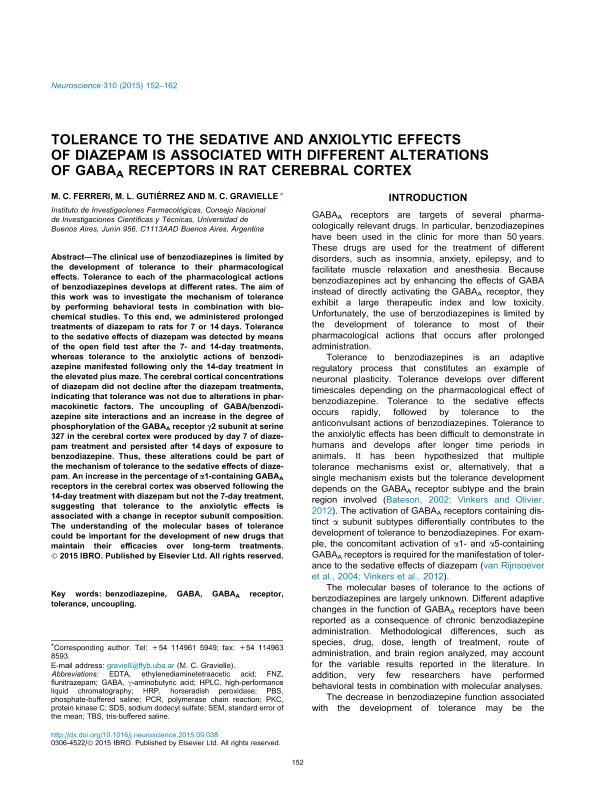Mostrar el registro sencillo del ítem
dc.contributor.author
Ferreri, Maria Celeste

dc.contributor.author
Gutiérrez, María Laura

dc.contributor.author
Gravielle, Maria Clara

dc.date.available
2018-03-14T20:59:13Z
dc.date.issued
2015-12
dc.identifier.citation
Ferreri, Maria Celeste; Gutiérrez, María Laura; Gravielle, Maria Clara; Tolerance to the sedative and anxiolytic effects of diazepam is associated with different alterations of GABAA receptors in rat cerebral cortex; Pergamon-Elsevier Science Ltd; Neuroscience; 310; 12-2015; 152-162
dc.identifier.issn
0306-4522
dc.identifier.uri
http://hdl.handle.net/11336/38838
dc.description.abstract
The clinical use of benzodiazepines is limited by the development of tolerance to their pharmacological effects. Tolerance to each of the pharmacological actions of benzodiazepines develops at different rates. The aim of this work was to investigate the mechanism of tolerance by performing behavioral tests in combination with biochemical studies. To this end, we administered prolonged treatments of diazepam to rats for 7 or 14days. Tolerance to the sedative effects of diazepam was detected by means of the open field test after the 7- and 14-day treatments, whereas tolerance to the anxiolytic actions of benzodiazepine manifested following only the 14-day treatment in the elevated plus maze. The cerebral cortical concentrations of diazepam did not decline after the diazepam treatments, indicating that tolerance was not due to alterations in pharmacokinetic factors. The uncoupling of GABA/benzodiazepine site interactions and an increase in the degree of phosphorylation of the GABAA receptor γ2 subunit at serine 327 in the cerebral cortex were produced by day 7 of diazepam treatment and persisted after 14days of exposure to benzodiazepine. Thus, these alterations could be part of the mechanism of tolerance to the sedative effects of diazepam. An increase in the percentage of α1-containing GABAA receptors in the cerebral cortex was observed following the 14-day treatment with diazepam but not the 7-day treatment, suggesting that tolerance to the anxiolytic effects is associated with a change in receptor subunit composition. The understanding of the molecular bases of tolerance could be important for the development of new drugs that maintain their efficacies over long-term treatments.
dc.format
application/pdf
dc.language.iso
eng
dc.publisher
Pergamon-Elsevier Science Ltd

dc.rights
info:eu-repo/semantics/openAccess
dc.rights.uri
https://creativecommons.org/licenses/by-nc-nd/2.5/ar/
dc.subject
Benzodiazepine
dc.subject
Gaba
dc.subject
Gabaa Receptor
dc.subject
Tolerance
dc.subject
Uncoupling
dc.subject.classification
Otras Ciencias Biológicas

dc.subject.classification
Ciencias Biológicas

dc.subject.classification
CIENCIAS NATURALES Y EXACTAS

dc.title
Tolerance to the sedative and anxiolytic effects of diazepam is associated with different alterations of GABAA receptors in rat cerebral cortex
dc.type
info:eu-repo/semantics/article
dc.type
info:ar-repo/semantics/artículo
dc.type
info:eu-repo/semantics/publishedVersion
dc.date.updated
2018-03-13T18:13:05Z
dc.journal.volume
310
dc.journal.pagination
152-162
dc.journal.pais
Estados Unidos

dc.description.fil
Fil: Ferreri, Maria Celeste. Consejo Nacional de Investigaciones Científicas y Técnicas. Oficina de Coordinación Administrativa Houssay. Instituto de Investigaciones Farmacológicas. Universidad de Buenos Aires. Facultad de Farmacia y Bioquímica. Instituto de Investigaciones Farmacológicas; Argentina
dc.description.fil
Fil: Gutiérrez, María Laura. Consejo Nacional de Investigaciones Científicas y Técnicas. Oficina de Coordinación Administrativa Houssay. Instituto de Investigaciones Farmacológicas. Universidad de Buenos Aires. Facultad de Farmacia y Bioquímica. Instituto de Investigaciones Farmacológicas; Argentina
dc.description.fil
Fil: Gravielle, Maria Clara. Consejo Nacional de Investigaciones Científicas y Técnicas. Oficina de Coordinación Administrativa Houssay. Instituto de Investigaciones Farmacológicas. Universidad de Buenos Aires. Facultad de Farmacia y Bioquímica. Instituto de Investigaciones Farmacológicas; Argentina
dc.journal.title
Neuroscience

dc.relation.alternativeid
info:eu-repo/semantics/altIdentifier/doi/http://dx.doi.org/10.1016/j.neuroscience.2015.09.038
dc.relation.alternativeid
info:eu-repo/semantics/altIdentifier/url/https://www.sciencedirect.com/science/article/pii/S030645221500857X
Archivos asociados
